|
Donna on the Side
|
|||||||||||||||||||||||||||||||||||||||||||||||||||||||||||||||||||||||||||||||
| Most of the independence history is within a one mile area in downtown Philadelphia. The place to start is Independence Visitor Center in Independence National Historical Park at One North Independence Mall West at 6th and Market Streets. You'll find lots of information for planning your visit. Also, there is the Constitutional Walking Tour of Philadelphia (www.TheConstitutional.com) to help guide you through the experience. It points the way for a tour that can be short or long. It is great for identifying where to go and providing some information for understanding the significance of the various stops, especially if you're short on time. | |
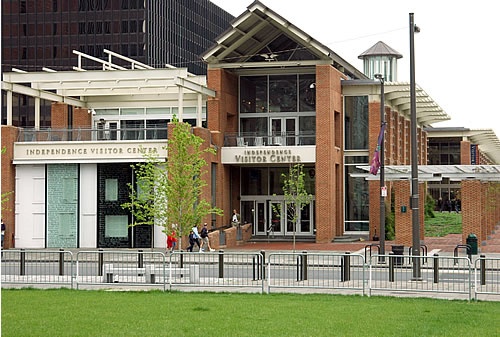 |
|
I started with one of the most familiar symbols of our government--the Liberty Bell. There is a whole building devoted to the history of the bell and the importance of liberty from the colonial days through slavery to today. You can see the Liberty Bell without charge. The first step is to get through security-- bags and you go through x-ray. One can't help but notice the impact that 911 has had on historical places and symbols. Completing security gets you through the Independence area which includes the Liberty Bell Center and the Independence Hall area. |
|
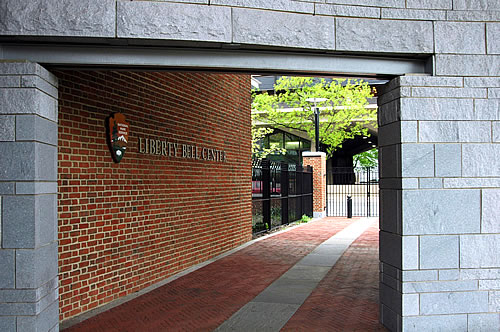 |
|
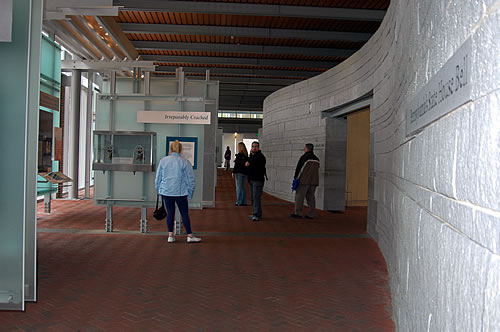 |
|
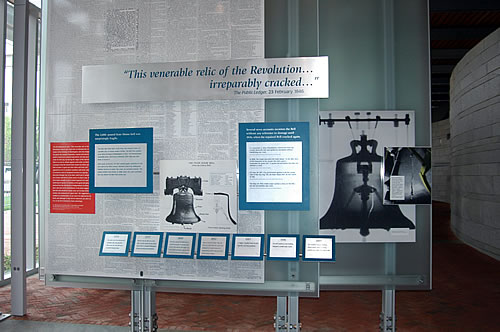 |
|
The Liberty Bell and Independence Hall sit across the street from each other--each representing an aspect of the formative days. the Liberty is the official bell of the Pennsylvania State House, which is today called Independence Hall. It rang many times for public announcements and may have rung July 8, 1776 to announce the first public reading of the Declaration of Independence. The bell weighs about 2,000 pounds. In 1846 a crack was discovered, silencing the bell. |
|
 |
|
The next stop on the tour is Independence Hall. This is the birthplace of America. It was built in 1732 as the Pennsylvania State House. Inside, the Second Continental Congress met in May 1775, and the Declaration of Independence was adopted on July 4, 1776. Independence Hall was also the site of the Constitutional Convention for drafting, debating and then signing the United States Constitution on September 17, 1787. A free timed ticket is required to enter Independence Hall and take part in the tours. To the right of Independence Hall is Congress Hall which served as the United States Capitol from 1790 to 1800 when Philadelphia was the Capital of the United States. To the left of Independence Hall is Old City Hall which was the seat of the united States Supreme Court from 1791 until 1800 when the Capital of the united States was moved from Philadelphia to Washington D.C. |
|
 |
|
 |
Philadelphia is full of cobble streets and colonial design buildings. 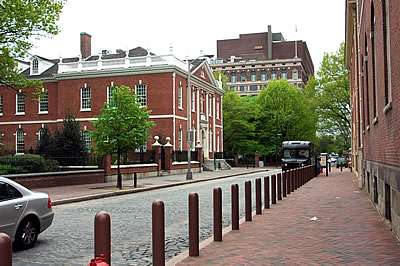 |
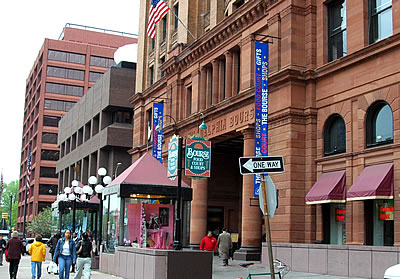 |
The Bourse Building Food Court is a good spot to take a break and get a snack. |
| Opposite Independence hall at the other side of Independence Mall is the National Constitution Center. The Center tells the story of the United States Constitution from Revolutionary times to the present through more than 100 interactive and multimedia exhibits, film, photographs, text, sculpture and artifacts. | |
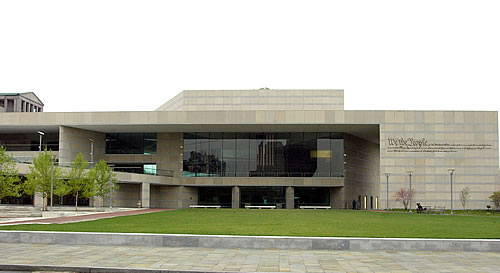 |
|
| Katty corner from the National Constitution Center is Christ Church Burial Ground which is the burial site for many of the founding statesmen, including Benjamin Franklin. | |
 |
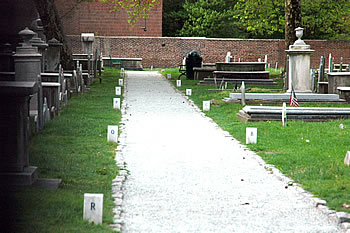 |
| Keep going down Arch Street and you'll find Betsy Ross's House. The house was originally built in 1740 and restored to the 1777 era. In 1777 Betsy Ross was commissioned by George Washington to create the first American Flag. Although no official records exist to prove the story of Ross creating the legendary "Stars and Stripes," the descendants of Ross have passed her story down from generation to generation. | |
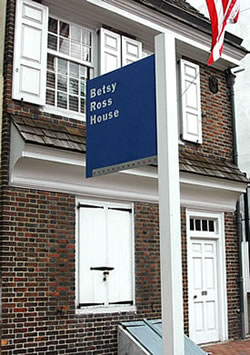 |
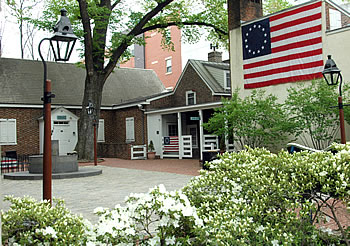 |
| From Arch Street south to Market Street is a cluster of buildings including B. Free Franklin Post Office & Museum, Franklin Court and the Franklin Museum. | |
This is a real US Post Office. It is a living portrayal of a bygone colonial lifestyle, and is the only active post office in the United States that does not fly the American flag. Benjamin Franklin was appointed Postmaster General in 1775. But this post office does not fly the American Flag (because there was not yet one in 1775 when Benjamin Franklin was appointed.) |
|
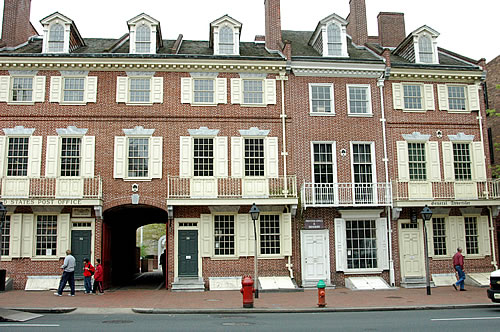 |
|
| Inside Franklin court through the archway | |
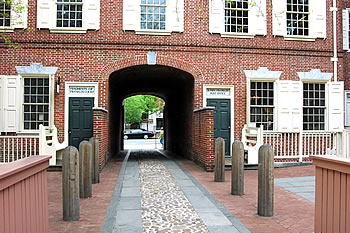 |
 |
| In Franklin court you will also find the "Ghost House." It is Robert Venturi's design to represent Benjamin Franklin's house which once stood in Franklin Court. It was razed in 1812. Below Franklin court is a museum which is filled with paintings, objects and inventions. | |
 |
|
Part of the Independence Historical scene is an area called the Old City District. This area is under renovation and has become a cultural area with housing, restaurants and shops for those who like city living with modern comforts. The area describes itself as "The Hipstoric™ Old City District (OCD). It is a place of unique people, significant history, charming shops, intriguing night life, and just loads of entertainment. Come and find out why it's a great place to visit, work and live. We look forward to seeing you in the neighborhood! Independence Hall, Independence Visitor's Center, the National Constitution Center, the Liberty Bell Center are but a few of the countless historical attractions the OCD has to offer. Learn about our important history and the Old City of today, while eating and shopping at fun and interesting places!" (Old City District web site) |
|
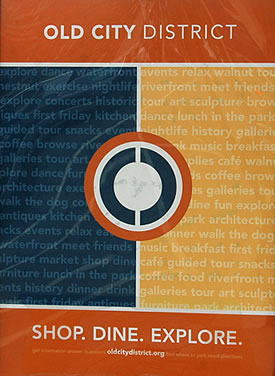 |
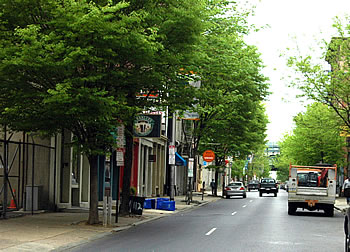 |
 |
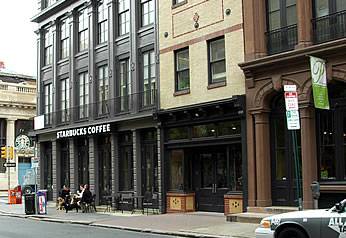 |
Of course there is a lot more to Philadelphia with museums, zoo and a host of other activities. Web Site for more information.
While I was touring, a park ranger told me that they don't get many visitors from the Penn Relays. Next year, I'd like to think it might be different. Hope this little tour piques your interest in independence history.See you next year at Penn! |
DyeStat ©1998-2005 |
|
John Dye - founder and editor in chief left, John and Donna Dye |